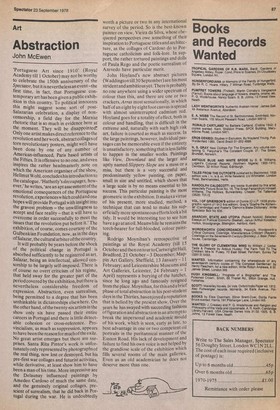Art
Abstraction
John McEwen
'Portuguese Art since 1910' (Royal Academy till 1 October) may not be worthy to celebrate the 150th anniversary of the Spectator, but it is nevertheless an event—the first time, in fact, that Portuguese contemporary art has been given a public exhibition in this country. To political innocents this might suggest some sort of postSalazarian celebration, a display of noncensorship, a field day for the Marxist rhetoric that is so much in evidence here at the moment. They will be disappointed! Only one artist makes direct reference to the revolution and her work, abstract collages of torn revolutionary posters, might well have been done by one of any number of American-influenced, Paris based artists of the Fifties. It is offensive to no one. and even inspires the rather headmasterly note on which the American organiser of the show, Hellmut Wohl, concludes his introduction to the catalogue. 'Hatherly's decoupages, however,' he writes, 'are an apt assessment of the emotional consequences of the Portuguese revolution, experiences which could and one hopes will provide Portugal with insight into the gravest problem — the unwillingness to accept and face reality — that it will have to overcome in order successfully to meet the issues that the revolution put before it.' The exhibition, of course, comes courtesy of the Gulbenkian Foundation, now, as in the days of Salazar, the cultural arbiter of the country.
It will probably be years before the shock of the political change in Portugal is absorbed sufficiently to be registered as art. Salazar, being an intellectual, allowed censorship to be largely self-imposed. There is of course no overt criticism of his regime, that held sway for the greater part of the period covered by the exhibition, but there is nevertheless considerable freedom of expression. Abstraction, even surrealism, being permitted to a degree that has been unthinkable in dictatorships elsewhere. On the other hand, of the twenty-six artists in the show only six have passed their entire careers in Portugal and there is little detectable cohesion or cross-reference. Provincialism, as much as suppression, appears to have been the reason for much of the exile. No great artist emerges but there are surprises. Santa Rita Pintor's work is unfortunately only represented by photographs of the real thing, now lost or destroyed, but his pre-first war collages and futurist activities, while derivative, at least show him to have been a man of his time. More impressive are the Delaunay influenced paintings by Amedeo Cardoso of much the same date, and the genuinely original collages, prescient of surrealism, that he did back in Portugal during the war. He is undoubtedly worth a picture or two in any international survey of the period. So is the best-known painter on view, Vieira da Silva, whose chequered perspectives owe something of their inspiration to Portuguese titles and architecture, as the collages of Cardoso do to Portuguese catholicism and folk-lore. In support, the rather tortured paintings and dolls of Paula Rego and the poetic surrealism of Azevedo have particular merit.
John Hoyland's new abstract pictures (Waddington till 30 September) are his most strident and ambitious yet. There is probably no one anywhere using a wider spectrum of colour than this, and there are one or two crackers, Arras most sensationally, in which half of an eight by eight foot canvas is spread with almost uninterrupted cadmium red. Hoyland goes for a totality of effect, both in colour and handling, that is difficult in the extreme and, naturally with such high risk art, failure is courted as much as success. In the large paintings, however, individual passages can be memorable even if the entirety is unsatisfactory, something that is less liable to happen in the smaller works. Paintings like View, Downland and the larger and aptly named Slippery Slope are a mess or a miss, but there is a very successful and prodominantly yellow painting, on paper, small in size and untitled, which shows that a large scale is by no means essential to his success. This particular painting is the most geometric in the exhibition. It makes a virtue of his present, more studied, method, a technique that can tend to make his superficially more spontaneous efforts look a bit tidy. It would be interesting too to see him have a go at an oil. Meanwhile he remains the torch-bearer for full-blooded, colour painting. Rodrigo Moynihan's retrospective of paintings at the Royal Academy (till 15 October and then on tour to Cartwright Hall, Bradford, 21 October — 3 December; Mappin Art Gallery, Sheffield, 13 January — 11 February; and Leicestershire Museums and Art Galleries, Leicester, 24 February — 1 April) represents a burying of the hatchet, since he long ago and famously resigned from the place. Moynihan, for this and a brief phase of total abstraction in his post-student days in the Thirties, has enj oyed a reputation that is belied by the present show. Over the years he has swayed with succeeding fashions of figuration and abstraction in an attempt to break the impersonal and academic mould of his work, which is seen, early as late, to best advantage in one or two competent oil portraits in the puritannical manner of the Euston Road. His lack of development and failure to find his own voice is not helped by the grandiose scale of the exhibition which fills several rooms of the main galleries. Even as an old academician he does not deserve more than one.


































































































 Previous page
Previous page